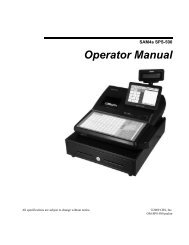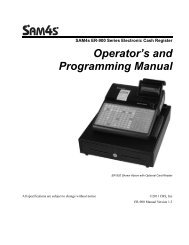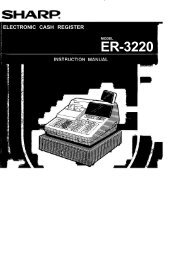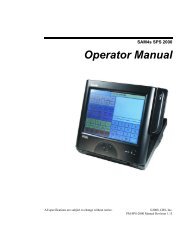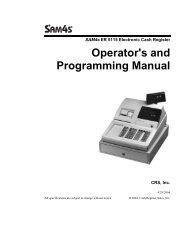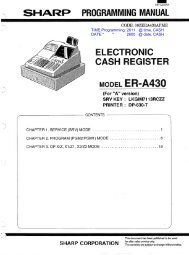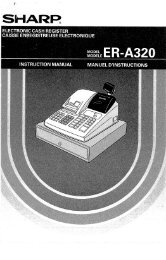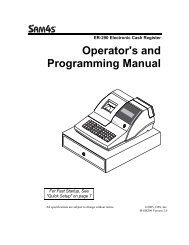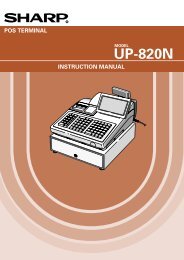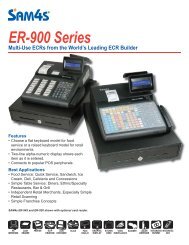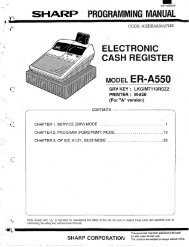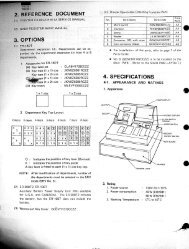SAM4s SPS-500 series programming manual.pdf
SAM4s SPS-500 series programming manual.pdf
SAM4s SPS-500 series programming manual.pdf
You also want an ePaper? Increase the reach of your titles
YUMPU automatically turns print PDFs into web optimized ePapers that Google loves.
1-2 Servicing PrecautionsWARNING: First read the-Safety Precautions-section of this <strong>manual</strong>. If some unforeseen circumstance creates aconflict between the servicing and safety precautions, always follow the safety precautions.WARNING: An electrolytic capacitor installed with the wrong polarity might explode.1. Servicing precautions are printed on the cabinet.Follow them.2. Always unplug the units AC power cord from theAC power source before attempting to:(a) Remove or reinstall any component or assembly(b) Disconnect an electrical plug or connector(c) Connect a test component in parallel with anelectrolytic capacitor3. Some components are raised above the printedcircuit board for safety. An insulation tube or tapeis sometimes used. The internal wiring issometimes clamped to prevent contact withthermally hot components. Reinstall all suchelements to their original position.4. After servicing, always check that the screws,components and wiring have been correctlyreinstalled. Make sure that the portion around theserviced part has not been damaged.5. Check the insulation between the blades of the ACplug and accessible conductive parts (examples: metal panels and input terminals).6. Insulation Checking Procedure:Disconnect the power cord from the AC source andturn the power switch ON. Connect an insulationresistance meter (<strong>500</strong>V) to the blades of AC plug.The insulation resistance between each blade of theAC plug and accessible conductive parts (seeabove) should be greater than 1 megohm.7. Never defeat any of the B+ voltage interlocks.Do not apply AC power to the unit (or any of itsassemblies) unless all solid-state heat sinks arecorrectly installed.8. Always connect an instrument’s ground lead to theinstrument chassis ground before connecting thepositive lead ; always remove the instrument’sground lead last.1-3 Precautions for Electrostatically Sensitive Devices (ESDs)1. Some semiconductor (solid state) devices are easilydamaged by static electricity. Such components arecalled Electrostatically Sensitive Devices (ESDs);examples include integrated circuits and some fieldeffecttransistors. The following techniques willreduce the occurrence of component damage causedby static electricity.2. Immediately before handling any semiconductorcomponents or assemblies, drain the electrostaticcharge from your body by touching a known earthground. Alternatively, wear a discharging wriststrapdevice. (Be sure to remove it prior to applyingpower - this is an electric shock precaution.)3. After removing an ESD-equipped assembly, placeit on a conductive surface such as aluminum foil toprevent accumulation of electrostatic charge.4. Do not use freon-propelled chemicals. These cangenerate electrical charges that damage ESDs.5. Use only a grounded-tip soldering iron whensoldering or unsoldering ESDs.6. Use only an anti-static solder removal device.Many solder removal devices are not rated as antistatic;these can accumulate sufficient electricalcharge to damage ESDs.7. Do not remove a replacement ESD from itsprotective package until you are ready to install it.Most replacement ESDs are packaged with leadsthat are electrically shorted together by conductivefoam, aluminum foil or other conductive materials.8. Immediately before removing the protectivematerial from the leads of a replacement ESD,touch the protective material to the chassis orcircuit assembly into which the device will beinstalled.9. Minimize body motions when handling unpackagedreplacement ESDs. Motions such as brushingclothes together, or lifting a foot from a carpetedfloor can generate enough static electricity todamage an ESD.



